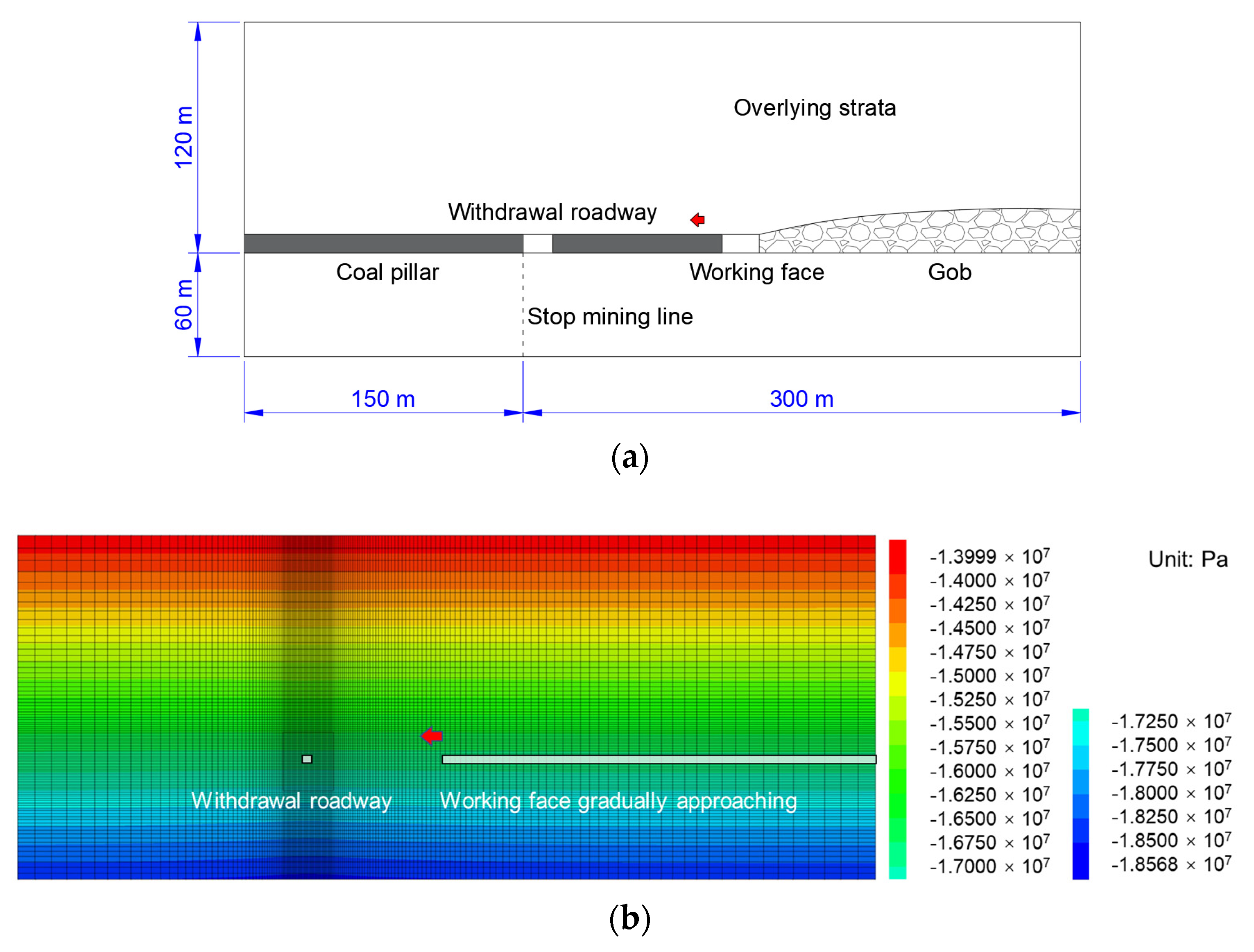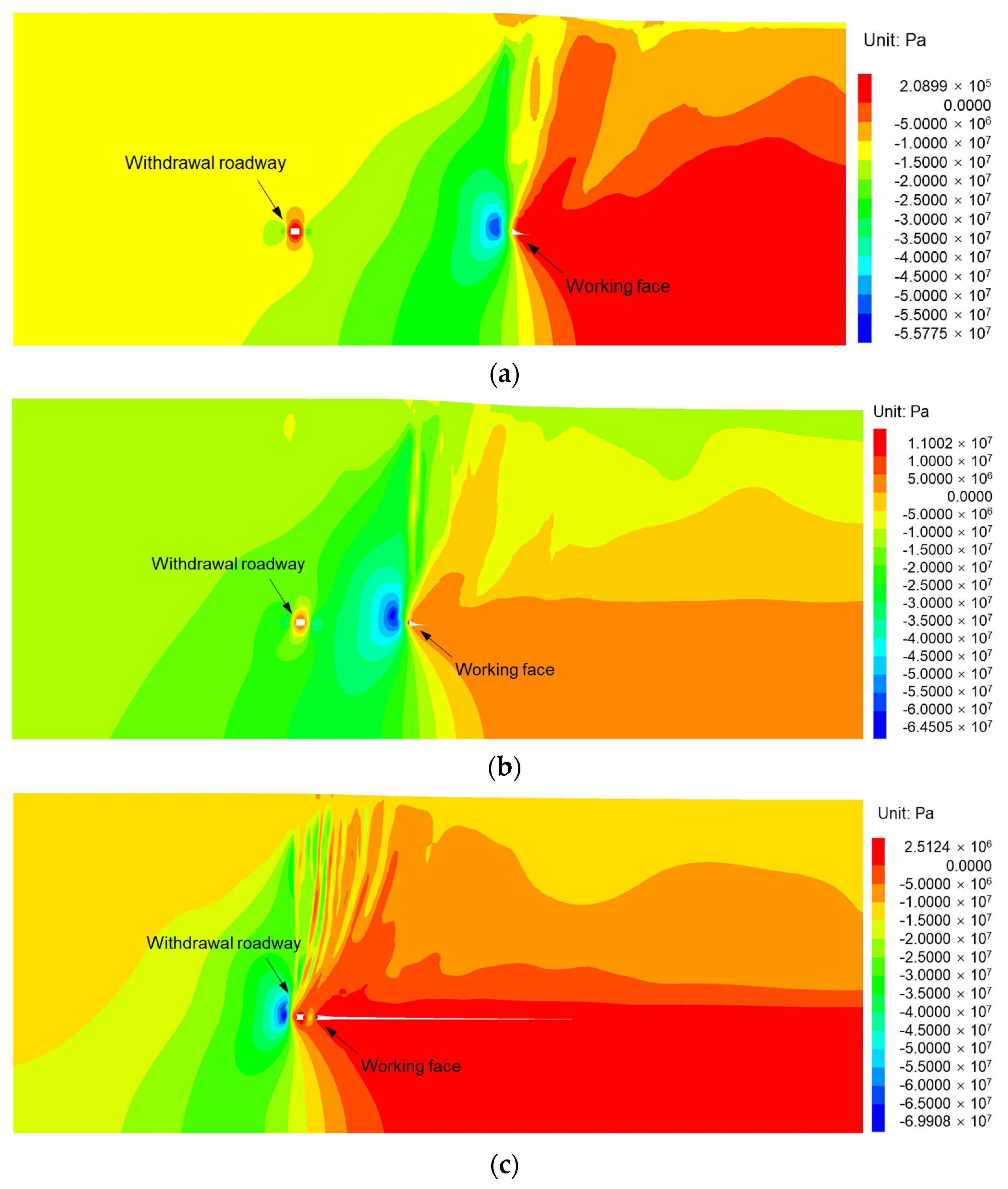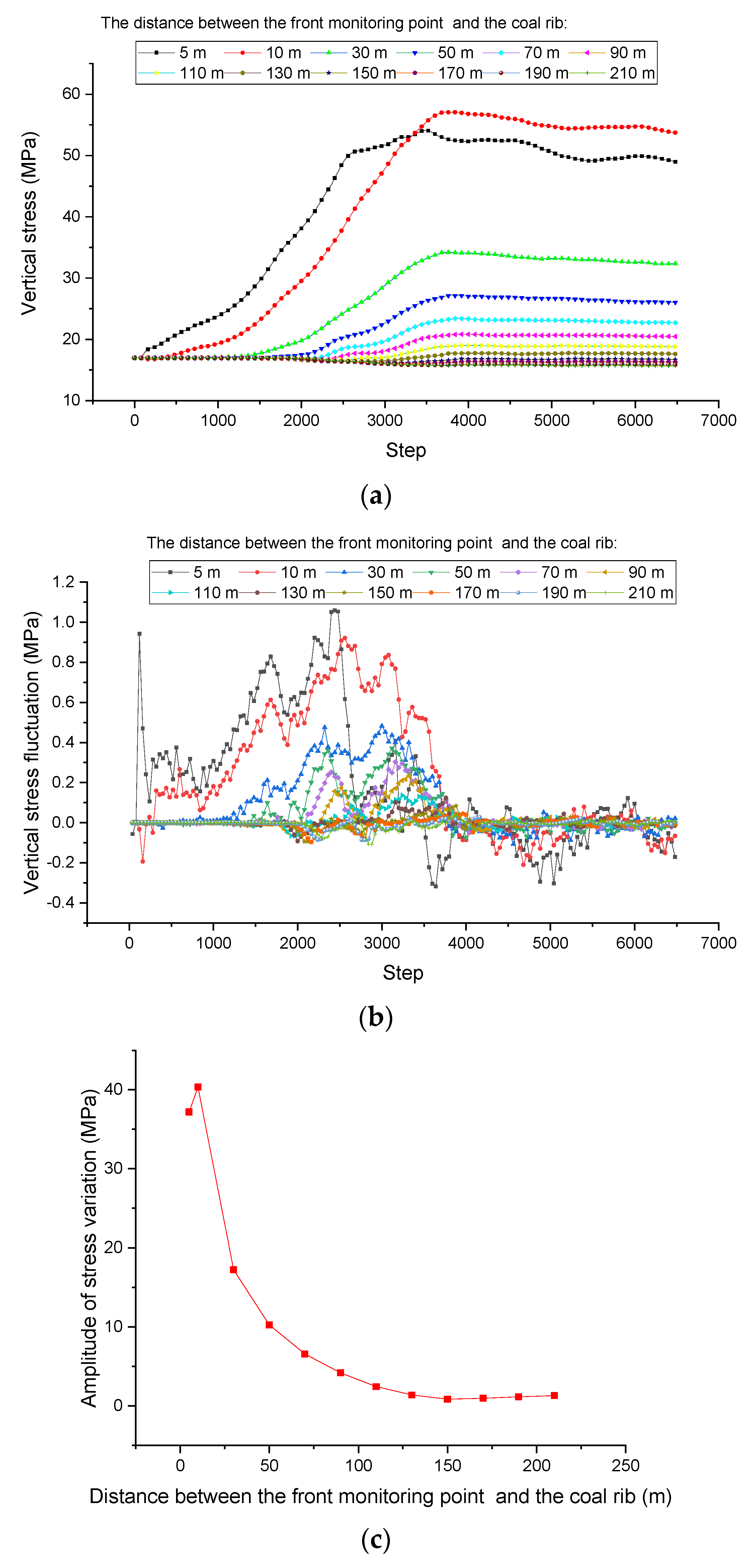The withdrawal roadway is a specialized mining roadway arranged at the stop-mining line of a coal mining face. It serves as a direct connection to the gob after the completion of mining operations, providing crucial spatial support for withdrawing the mining equipment. The roof control of the withdrawal roadway is an important guarantee for the safe and rapid retreat of the mining equipment from the working face. However, during the final mining period, the withdrawal roadway will be connected to the coal mining face, which will cause severe deformation, fracture, and instability of the surrounding rock in this roadway due to strong mining influence. This poses a formidable challenge for roof control and has been a persistent issue affecting mine production.
1. Introduction
The withdrawal roadway is a specialized mining roadway arranged at the stop-mining line of a coal mining face. It serves as a direct connection to the gob after the completion of mining operations, providing crucial spatial support for withdrawing the mining equipment
[1][2]. The mining areas in the Inner Mongolia Autonomous Region and Shaanxi Province are the core regions of coal production in China, and the deep mining method has been widely employed in these mining areas
[3][4][5]. To ensure the safe and efficient mining of deep coal, the mining equipment should be transported and withdrawn efficiently. The roof control of the withdrawal roadway is an important guarantee for the safe and rapid retreat of the mining equipment from the working face. However, during the final mining period, the withdrawal roadway will be connected to the coal mining face, which will cause severe deformation, fracture, and instability of the surrounding rock in this roadway due to strong mining influence. This poses a formidable challenge for roof control and has been a persistent issue affecting mine production
[6][7][8].
The weighting characteristics of the withdrawal roadway mainly depend on the distribution of the front abutment pressure in the working face
[9][10]. The classic mine pressure theory points out that the front abutment pressure along the advancing direction of the working face can be divided into the following three zones: the stress reduction zone, the abutment pressure zone and the original-rock stress zone. Researchers have conducted many studies on front abutment pressure. It has been concluded that the value and distribution range of the stress reduction zone and abutment pressure zone significantly affect the stability of the surrounding rock of the withdrawal roadway. Yang et al.
[11] studied the influence of the fracture location of the main key layer of the roof on the stability of the surrounding rock of the withdrawal roadway and proposed a differentiated support plan for the withdrawal roadway. He et al.
[12] pointed out that the stop-mining line should be reasonably designed to ensure that the main key layer fracture line is located behind the hydraulic support. Li et al.
[13] put forward the treatment method for the manifestation of strong strata behaviors by using hydraulic fracturing technology to break the key stratum and to protect the reserved roadways. Under the mining conditions of a 15-m-thick coal seam in the Datong mining area, Xie et al.
[14] conducted a case study on the distance between the stop-mining line and the location of the main key layer fracture line of the roof. It was concluded that, when the stop-mining line distance is slightly greater than the length of the key block, the stability of the surrounding rock in the withdrawal roadway is optimal.
2. Impact of Mining on Withdrawal Roadway
2.1. Modeling of the Spatial Structure of the Withdrawal Roadway and the Stope
A FLAC numerical simulation model was established based on the engineering conditions of the withdrawal roadway, as shown in Figure 1. The upper boundary of the model was subjected to stress constraints, with a vertical stress of 14 MPa, and all of the other boundaries were subjected to displacement constraints. The rock strength criterion used was the Mohr–Coulomb criterion. During the simulation process, the working face gradually advanced, with a cumulative advancement of 300 m, until it was connected with the withdrawal roadway. During this period, the changes in the stress and deformation of the surrounding rock were monitored for the subsequent theoretical analysis.
Figure 1. Numerical calculation model of the withdrawal roadway and the working face: (a) The spatial relationship and size of the model; (b) Numerical modeling and in situ stress field.
Combined with the numerical simulation, this study focuses on the following three aspects: (1) the influence mechanism of the mining-induced stress on the strong deformation of the surrounding rock in the withdrawal roadway is analyzed in order to deepen the understanding of the problem of strong mining; (2) the influence range of the advanced mining on the working face is obtained in order to determine the reasonable excavation timing for the withdrawal roadway; and (3) the evolution law of stress and deformation in the surrounding rock of the withdrawal roadway during critical mining operations is summarized in order to determine the supporting parameters.
2.2. Influence Mechanism of Mining-Induced Stress on the Withdrawal Roadway
This study has demonstrated that there are four primary factors contributing to the severe deformation of the surrounding rock in the withdrawal roadway during mining activities, as follows:
(1) Abutment pressure. After roadway excavation, the abutment pressure is formed on both sides of the coal bodies. After coal seam mining, the roof of the coal seam undergoes periodic fracture, leading to stress transfer from the gob to the periphery. Among them, there is a high value of front abutment pressure distributed in front of the working face. As shown in
Figure 2, the peak value of the abutment pressure on both sides of the roadway is 22.8 MPa, which is 1.22 times higher than that of the original rock stress. The front abutment pressure significantly increases, and its peak value reaches 55.18 MPa, which is 3.25 times higher than that of the original rock stress. The abutment pressure caused by coal mining is 2.4 times higher than that caused by excavation. Therefore, the withdrawal roadway is more prone to deformation when it is disturbed by the mining of the working face. This is consistent with previous studies
[15].
Figure 2. Distribution curve of abutment pressure: (a) The abutment pressure of coal mass on both sides of the withdrawal roadway; (b) Front abutment pressure of working face 21405.
(2) Stress superposition. When the coal mining face is still at a certain distance from the withdrawal roadway, the front abutment pressure has already been superimposed with the abutment pressure inside of the surrounding rock of the withdrawal roadway. Figure 3 shows the vertical stress evolution of the coal seam roof when the working face is gradually advanced to the withdrawal roadway. When the distance between the working face and the withdrawal roadway is 245 m, the stress variation in the withdrawal roadway is the smallest. When the distance is 180 m, the stress variation is relatively small. When the distance is 115 m, the abutment pressure on both sides of the withdrawal roadway increases slightly. When the distance is 55 m, the abutment pressures on both sides are superimposed onto each other, and these values show a significant increase. When the distance between the two is 5 m, the position of the peak abutment pressure has already crossed the withdrawal roadway and reached the rear of the withdrawal roadway, and the peak stress is as high as 68.45 MPa. When the superimposed stress exceeds the bearing capacity of the surrounding rock (especially the coal body), a strong deformation of the withdrawal roadway occurs.
Figure 3. Vertical stress distribution curve at different distances between the working face and the withdrawal roadway.
(3) Damage accumulation. During the disturbance period, the surrounding rock of the withdrawal roadway exhibits stress-induced responses. The deformation and failure of the rock mass are the most evident manifestations. Due to the continuous occurrence of stress variations, rock mass damage continues to accumulate, ultimately resulting in large deformation and instability.
(4) Stress fluctuation. Although stress fluctuation has often been overlooked in previous research, it plays a crucial role in the deformation and instability of the roadway surrounding rock under strong mining disturbance. Figure 4 shows the stress distribution nephogram of the rock layer when the working face is advanced to a distance of 115 m, 55 m, and 5 m from the withdrawal roadway, respectivley. Figure 3 shows the stress value of the coal seam roof. At this time, the stress of each point in the figure seems to be determined, while the stress at every point in the rock mass undergoes a complex wave-like evolution process.
Figure 4. Vertical stress nephogram when the distance between the working face and the withdrawal roadway is (a) 115 m; (b) 55 m; (c) 5 m.
Figure 5a–c shows the stress evolution curve, stress fluctuation curve, and stress amplitude curve of the coal body at different positions in front of the mining work under different mining disturbances. In the area 130 m away from the front of the working face, the stress fluctuation of the coal body is very small, and the amplitude of stress variation is also small, with a maximum change value of 0.83–1.36 MPa. This area can be considered as a weak disturbance area. In the range of 130–30 m in front of the working face, the stress fluctuation of the coal body is significantly enhanced, and the amplitude of stress variation also increases rapidly, with a maximum change value of 2.43–17.25 MPa. This area can be considered as a moderate disturbance area. In the range of 30 m to 0 m in front of the working face, the stress fluctuation of the coal body is the strongest. The range of stress variation in this area is 37.19–40.34 MPa, which has exceeded the original rock stress by two times. Frequent stress fluctuations are equivalent to the frequent loading and unloading of coal and rock masses, which are more likely to induce cracks and deformation. This may be the most important cause of the deformation and instability of the roadways under strong mining disturbance.
Figure 5. The evolution of vertical stress during mining: (a) The evolution curves of vertical stress at different measuring points in front of the working face; (b) The evolution curves of stress fluctuation value; (c) The amplitude of stress variation.
2.3. Excavation Timing of Withdrawal Roadway
The majority of mines aim to excavate the withdrawal roadway later in order to concentrate the construction efforts on the preparation and extraction of the working face. To mitigate the impact of the mining activities on the working face, the determination of the latest feasible time for excavating the withdrawal roadway has emerged as a significantly crucial concern in this scenario. Based on the law of rock pressure and the numerical simulation results, the following can be elucidated:
(1) The influence range of the front abutment pressure on the working face should not exceed 1.0–1.2 times that of the width of the working face
[16][17].
(2) From the analysis of the abutment pressure characteristics, the influence range of the front abutment pressure on working face 21405 is 142.7 m (0.47 times more than that of the width of the working face), while the influence range of the abutment pressure on the withdrawal roadway is 28.2 m (5.9 times more than that of the width of the withdrawal roadway).
(3) The stress superposition occurs when the distance between the working face and the withdrawal roadway is 115 m.
(4) At 130 m in front of the working face, the stress fluctuation of the coal body significantly increases.
From the perspective of facilitating the maintenance and control of the withdrawal roadway, the maximum distance of 171 m (which is the sum of the influence ranges of the abutment pressure between the working face and the roadway) can be selected as a safe distance to avoid significant disturbances. In other words, reasonable timing should be selected to ensure that the distance between the coal face and the withdrawal roadway is greater than 171 m when the excavation of the withdrawal roadway is completed. Considering that the excavation speed v1 and the mining speed v2 are not consistent, the following function can be used to determine the excavation timing:
When the distance between the coal mining face and the designated position of the withdrawal roadway reaches L, the excavation of the withdrawal roadway must commence. During on-site implementation, if there are changes in mining production (for example, if the excavation speed of the withdrawal roadway is slowed down or the mining speed of the working face is accelerated), this distance can be appropriately enlarged.










